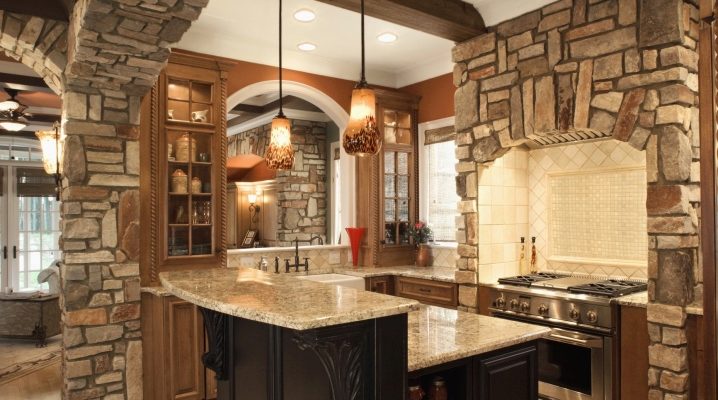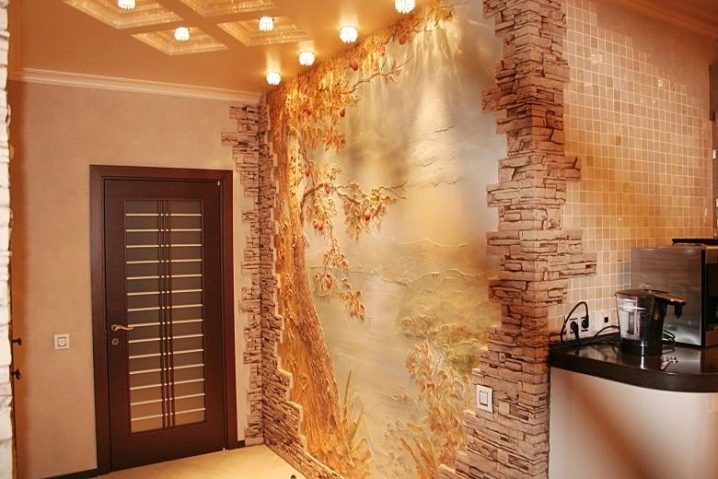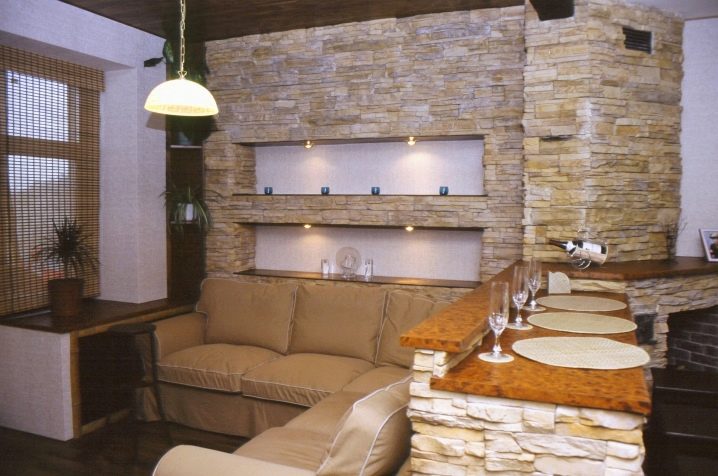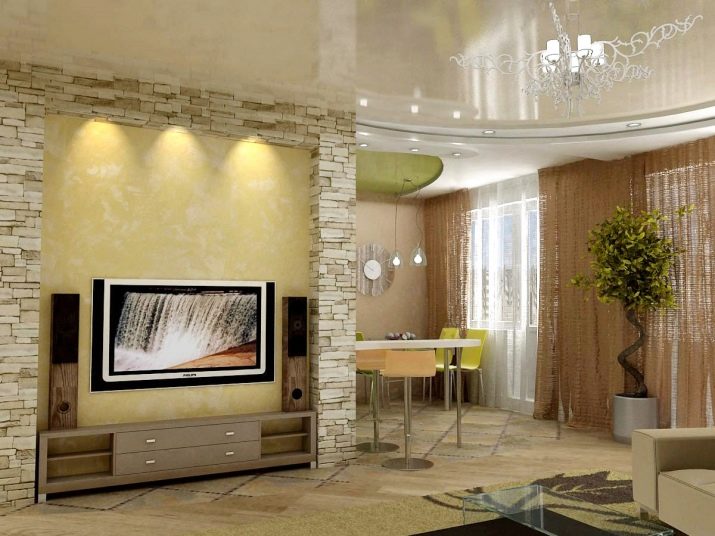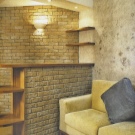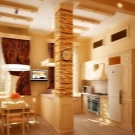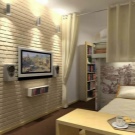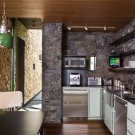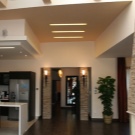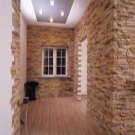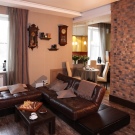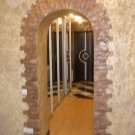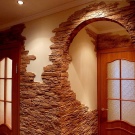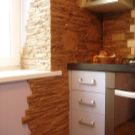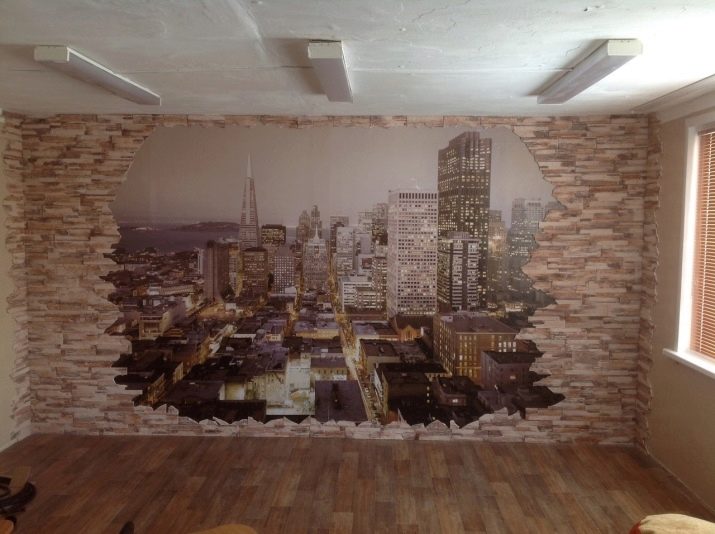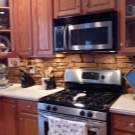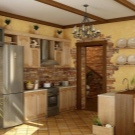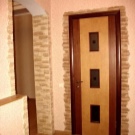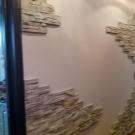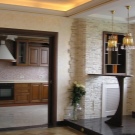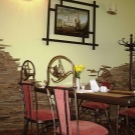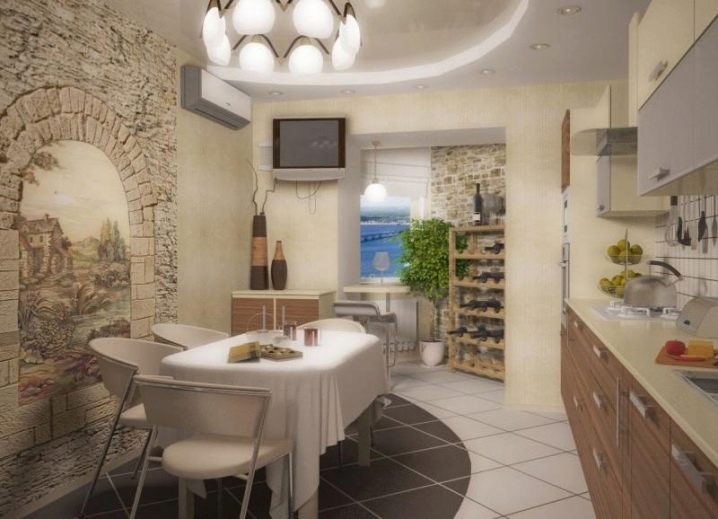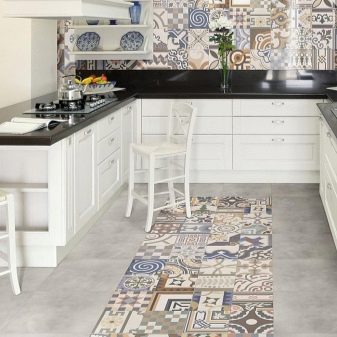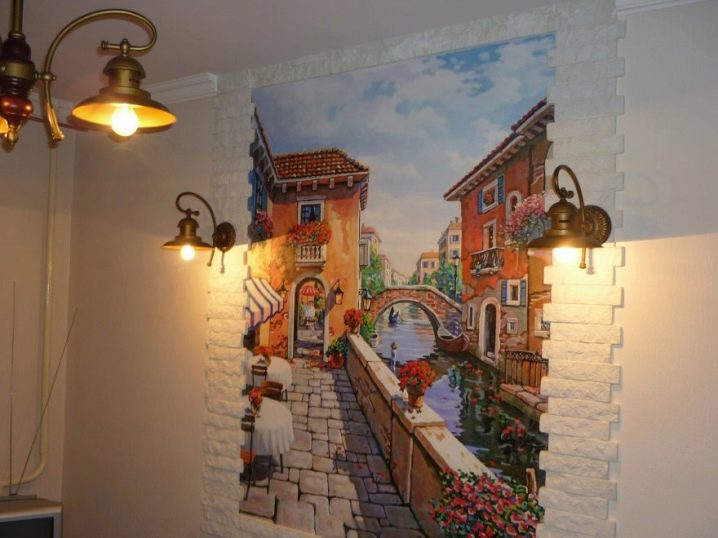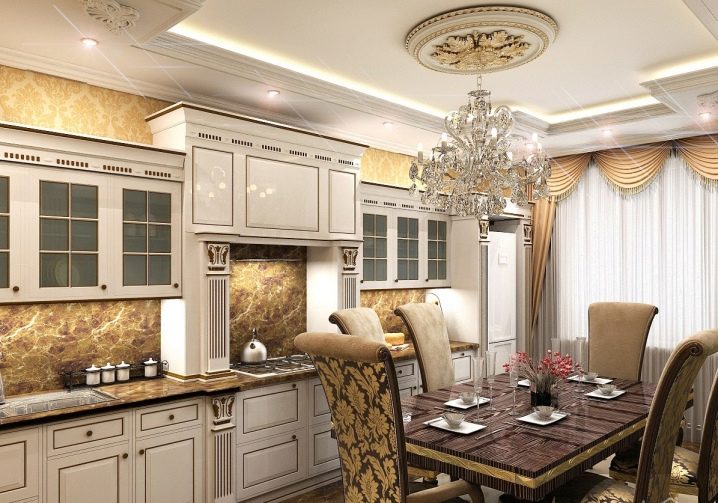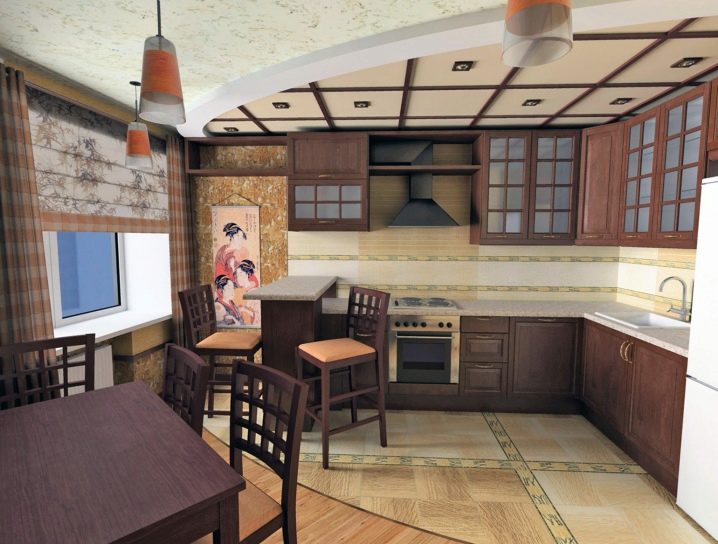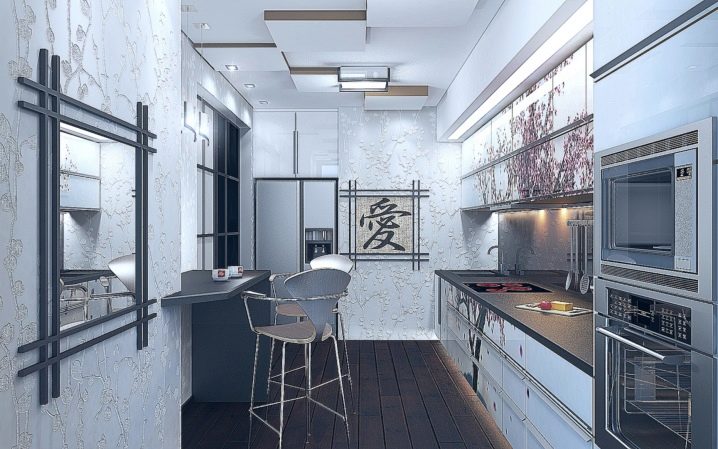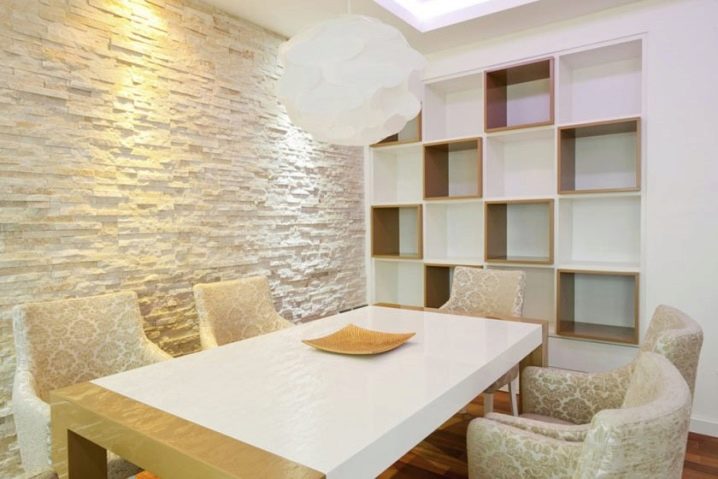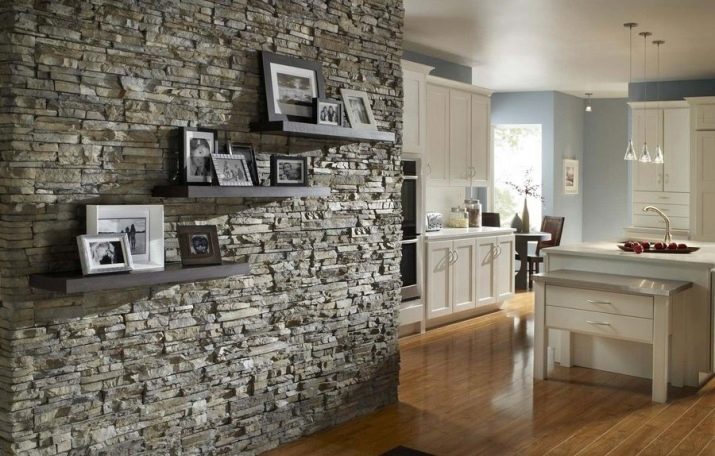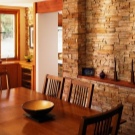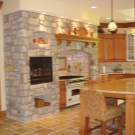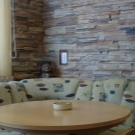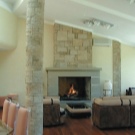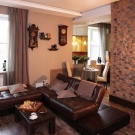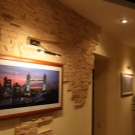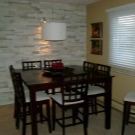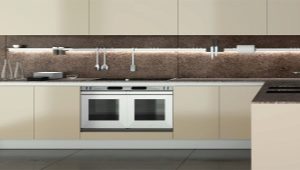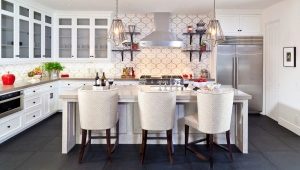Decorating kitchens wallpaper and decorative stone
In order for the repair in the kitchen for a long time to please its owners with a pleasant view, it is necessary to select the finishing materials correctly. If you choose wallpaper for wall decoration, you should pay attention to waterproof coatings.
A wonderful option for decorating kitchen walls is duplex wallpaper. They are not composed of several layers of paper and are coated with a special compound that makes them resistant to fading and moisture. Wallpapers have a different texture of the upper unpainted surface, which after sticking is painted with dispersed paint. Duplex wallpaper, depending on its density can withstand up to 15 layers of paint. After dyeing, they do not lose their breathable ability. The quality of performance can be compared with expensive vinyl wallpaper.
Wall decoration only wallpaper today is no longer in vogue. They are usually combined with other materials. Most often for the working area choose ceramic tiles. It is practical, but not original.If you want to make kitchen design not only practical, but also fashionable, try various combinations of stone and wallpaper. The decoration can be used as a plate of natural minerals, and from artificial. The natural option is considered more durable and durable, and artificial stone is more affordable.
Advantages of decoration with decorative stone:
- Slabs of stone are very resistant to various kinds of mechanical stress. They retain their original color and pattern well for quite a long time, so they can lay out not only the "kitchen apron", but also the areas near the door jambs, sockets and switches
- Stone fits easily into any style. With it, you can create absolutely any design: from classic to the most avant-garde.
- As a decorative stone is not a cheap pleasure, it can be combined with wallpaper of any texture.
- A stone can be part of a composition on photo wallpapers with a perspective - a pavement, a window or garden arch - there can be many options.
- The rough surface looks most advantageous in contrast with glossy.It can be mirror inserts, plastic panels, glazed tiles, etc.
- Decorative stone tiles are neither toxic nor hazardous to health, resistant to ignition.
- The material is not susceptible to large temperature differences, which allows its use in the area near the stove, battery and near the window.
- The stone is not susceptible to infection by mold and fungus.
Finishing features
- If the kitchen area is small, there should not be too much stone in the decoration. This visually reduces the room, makes it dark and looks like a basement. Even in large rooms, it is better to use stone tiles fragmentary - to focus on the details or on one wall.
- Such tiles should not be glued to drywall partitions - this is too fragile support for such a finish. Decorative plaster tiles imitating stone are well suited for such a wall. By design, they are not inferior to the present, and weigh significantly less.
- When making rounded arches, also use plaster and cement tiles or thin plates.
- Select the right lighting. A direct hit of light smoothes out the unevenness of the relief, and the rays of light, illuminating the stone from above or below, due to the complex play of shadows can give it additional volume.
- It is possible to glue a plaster tile under a stone on wallpaper only on small areas - no more than 1-3 tiles. If there is a large-scale composition, it is better to lay it on the wall.
- To make the composition look neat and to have a finished look, when cutting the wallpaper, you should leave a small overlap under the stone tiles.
Styles and Directions
Provence
Here it will be appropriate to large tiles in bright colors, imitating brick tiles and wooden elements. Complete the kitchen design with wrought-iron furniture and wall sconces in the same style.
Patchwork
Earlier, this was the name of the patchwork technology. Composition in this direction can be made independently of decorative tiles. To do this, you can pick up the remains of various collections in stores. Sometimes they are sold at discounted prices, which will help save on materials. The main rule when creating a patchwork style composition is to match tiles in size and thickness. As for the color range, there are no clear rules and full freedom of fantasy reigns.
Antique style
This is a stone with the effect of antiquity, resembling elements of ancient frescoes.Color range: pastel, all shades of marble in combination with gold, the color of young green. These can be stone tiles that imitate arches, balcony curbs and curtain rods. Now there appeared on the market wallpaper with an embossed pattern in the antique style - fragments of ancient Roman statues, ancient narrow streets with paved pavements and even pompous monuments such as the Colosseum. These wallpapers are very well combined with stone tiles, which is a continuation of the pattern on the wallpaper.
Baroque
This is the style of palaces and fountains, the kingdom of gold and crystal, the abundance of frescoes and stucco. The stone lithok in the Baroque style is replete with floral ornaments and a complex ornate pattern. Here it will be appropriate slabs of onyx and marble or imitation for them. Baroque - flashy luxury, style of people who do not tolerate half tones.
Japanese style
This is no frills style. Maximum simplicity and the complete absence of unnecessary things. Only natural materials are recognized - wood, bamboo, clay, rice paper. No luxury and pomp. And that means that the tile should be calm tones, resembling the texture of natural materials.
In Japan, dark colors in the interior are not very popular.In favor of olive, coffee, milk. Caramel colors. For finishing, preference should be given to tiles in precisely these colors. Black color in the Japanese interior is used as a contrast. In contrast to the light tile, you can choose wallpaper with hieroglyphs and curtains or blinds in line with wallpaper.
High tech
Characteristic features of this style are the correct clear lines, specifics and efficiency, the complete absence of decorations. Everything, including tile, should be smooth, smooth and shiny. Here cold marble or another mineral with a smooth structure combined with plain wallpaper will be appropriate. Manufacturers of decorative tiles strive to exactly repeat all the inclusions and streaks of natural stones.
Classicism
For such a style in the interior are characterized by rounded lines, lightness, airiness throughout. The combination of the texture of natural stone with wallpaper under the skin will be most welcome here. Also be relevant tapestry wallpaper and wallpaper that mimic wall painting. The main rules of this style are strict symmetry, practicality of each accessory and rich finish.
